Cats are unique, loving species, but it’s not uncommon for felines to bite humans without apparent provocation. Cat biting isn’t always associated with hostility, and aggression isn’t a temperament or a diagnosis; it’s a result of how the cat feels at that moment.
Cats are natural hunters. Pouncing, clawing, and biting are normal parts of predation, play, and social behavior, which are essential for survival. Biting can be severe, injure humans and animals and transmit zoonosis from cats to people.
Let’s discover why your cat bites you and how to stop it before it begins.
IN THIS ARTICLE
Why Do Cats Bite?
Cats bite to express their feelings, communicate their intent or warn you to cease doing something they do not enjoy.
Here are a few common reasons for cats to mouth human body parts.
1. Kitten Biting

Hand-raised kittens or those who haven’t been socialized with other cats or handled by humans during the early socialization period may bite due to anxiety, fear, or reduced ability to cope with environmental changes.
2. Cat Love Bites
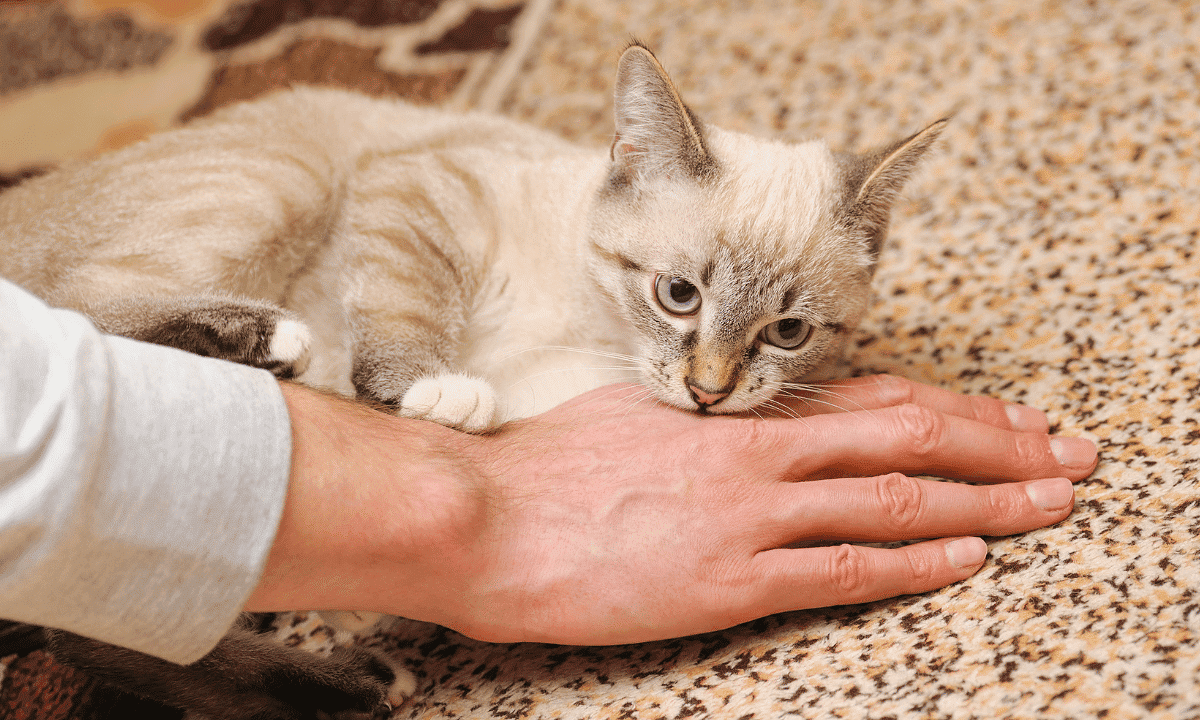
Love bites are a form of communication that usually indicates affection. Love bites typically begin with a tongue licking through grooming and slowly progress to gentle nibbles. Love bites don’t cause pain, draw blood or necessitate hospitalization.
3. Play Biting
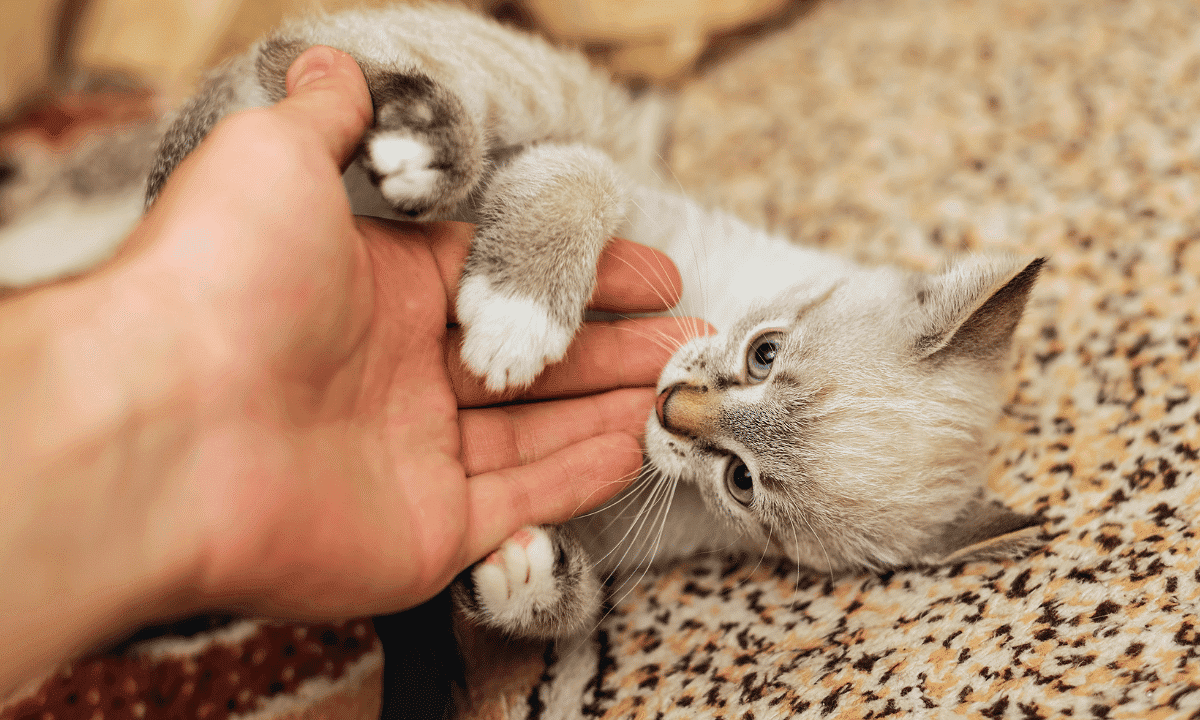
Play behavior is natural in cats, particularly in kittens.
Young cats that haven’t been raised with littermates or lacked play opportunities during kittenhood may display play aggression.
4. Fear or Anxiety Induced Biting

A vulnerable cat who perceives a threat and looming danger when placed in a carrier, taken to the vet, or cornered at home may bite out of anxiety and fear, especially if escape is inevitable.
5. Petting Aggression or Overstimulation
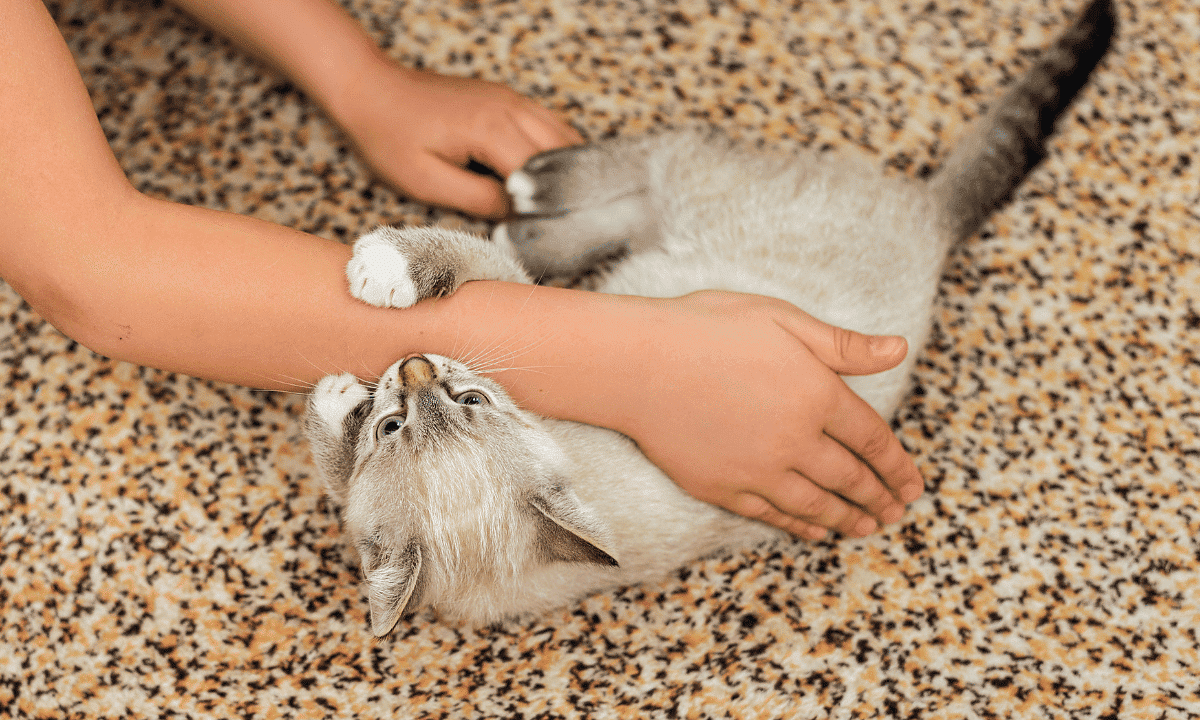
Petting aggression is unsettling to pet owners since it may seem the cat changed their minds about the interaction by scratching and biting their owner, although they were the ones who solicited the attention in the first place.
The cat becomes overstimulated or agitated when petted in vulnerable body parts like the chest, belly, or back, wanting to stop the interaction; this is relatively typical for felines who are less petting tolerant as they are socially mature.
6. Biting for Attention

A cat may solicit attention by rubbing, head-butting, meowing, or biting their owner when they want food, affection, or outdoor access. Remember not to reinforce the biting behavior by responding to your cat’s demands.
7. Redirected Aggression
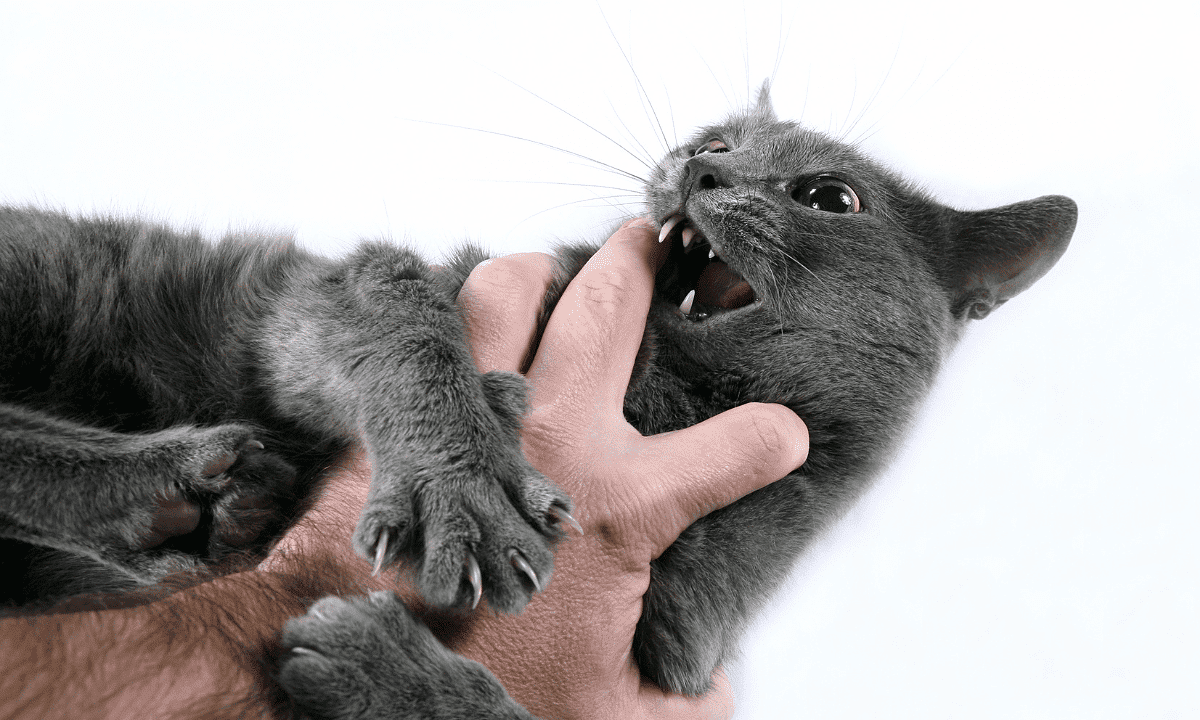
Redirected aggression occurs when a cat is agitated or aroused by a stimulus like another cat, individual, or event.
If the cat cannot deflect hostility towards the cause (i.e. cat outside the window), it may convey aggression by biting a nearby cat.
Similarly, redirected frustration can occur when a cat is frightened by a sudden loud noise, resulting in a redirected attack toward the owner instead of the original target.
How Do I Stop My Cat From Biting?

Don’t lure your kitten or cat into playing by jiggling your hands or toes, then get upset when your cat scratches or bites you. If your kitten or cat tries to nip on any human body parts, immediately stop the interaction and walk away to educate them that this behavior is unacceptable.
Expose cats to gentle, positive body handling. Discourage roughhousing during kittenhood to ensure your cat grows into a confident cat who enjoys stroking.
Provide daily interactive play and mental stimulation using cat toys to give your cat an appropriate hunting outlet and help them relax.
Increase hiding spaces (i.e. boxes, cat condos, tunnels) and perching spots (playgrounds, shelves, and window lookouts) to make your cat feel at ease and reduce competition in multi-cat households.
If your cat bites but won’t let go, push your hand or tap your cat on the shoulder to encourage your cat to release you.
Offer your cat security by decreasing changes within the home and keeping a predictable routine. If house relocation is inevitable, plug in a Feliway diffuser to reduce stress and fear-based aggression.
Lastly, avoid any punishment. If you chastise your cat, it may end up biting you straight away instead of warning you, or it may intensify its fear aggression which would cause your cat to avoid you or be scared of you.
How To Tell If My Cat Is Going to Bite?
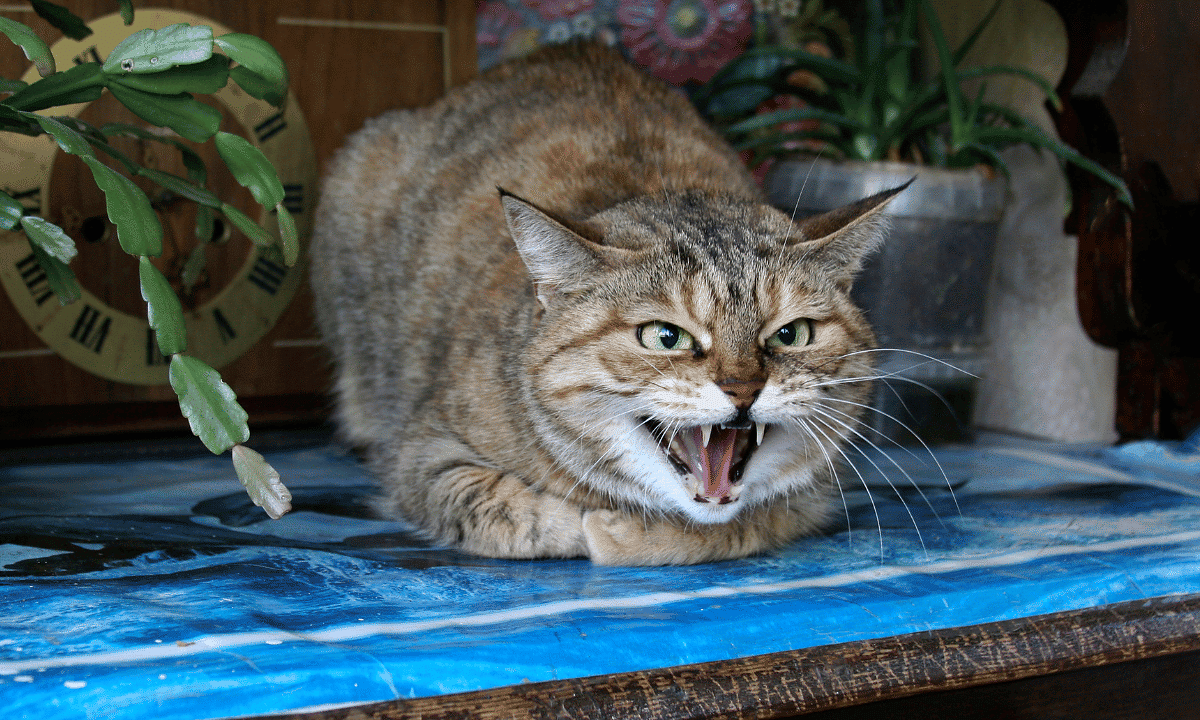
Cats only bite as a last resort and will provide you with plenty of body language cues before an attack.
Here are the warning signs to look out for when a cat is indicating it’s about to bite you:
- Pupil dilation or direct staring
- Head turn toward your hand
- Flattened ears and back against the head or ears rotated backward
- Twitching or tail thrashing from side to side
- Hissing, growling, or spitting
- Tense or crouched body posture
- Skin twitching or back rippling
- Sudden or excessive grooming
- Raised paw with exposed claws
- Trying to move or walk away
What Should I do If My Cat Bites Me Badly?
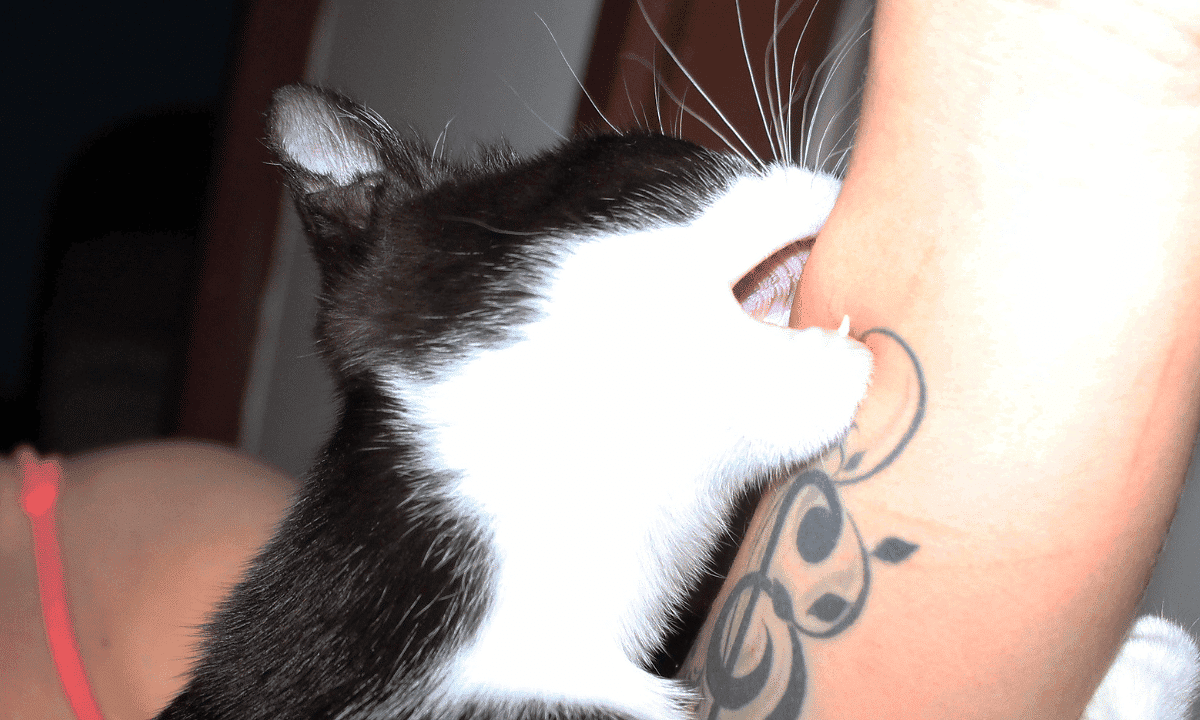
Stop instant interaction with your cat, don’t touch or approach them. Don’t shout or punish the cat since it may increase aggression.
It’s best to separate the cat from household members or pets by leaving it in the same room, allowing it to escape into another area, and shutting the door until the cat calms down.
Once the cat is confined, treat any human bites by rinsing it with running water. Seek medical attention immediately since cat bites tend to inflict puncture wounds, which will require a course of antibiotics.
Lastly, contact your veterinarian to discuss the incident and the trigger for the aggressive behavior.
How To Pet a Cat

Let a cat choose if they want to approach or interact with you.
Offer a stretched finger or loose clasped fist, otherwise an open hand with palm facing upwards, which allows the cat to smell or facial rub if they wish to interact.
Cats prefer to have choice and control; hence if the cat chooses not to interact, we must respect their wishes.
A cat prefers touching around the head and face. Avoid sensitive areas like the belly, back, and tail.
Once you stroke the cat, stop to observe what they do. If the cat moves towards you in a relaxed manner, continue with the interaction. However, if it moves away, stop the interaction.
Cats often prefer gentle petting with fingers or hands toward the fur, including scratching with fingertips under the chin and cheeks. Most cats favor short strokes, while others like slower, longer pats.
Always be cautious since even confident social cats may sometimes not be in the mood for petting.
FAQs
Why does my cat lick me and then bite me?
Cats may lick you and then bite you as a sign of affection. ‘Love bites’ are ticklish and do not hurt or pierce the skin or draw blood.
Are there any medical reasons why my cat might bite me?
Several medical reasons include acute or chronic pain that may trigger a cat to bite its owner. Dental disorders, Degenerative Joint Disease (DJD), FIC, Meningioma, Hyperesthesia Syndrome, and injury, can cause a cat to respond with antagonism.
Why does my cat bite me when I pick him up?
Choice and control are essential for cats. If you pick up your cat while they are eating, resting, or playing, you may surprise or scare them, causing them to bite you inadvertently. Furthermore, your cat may prefer to avoid handling or communicating that it does not want to interact.
Why does my cat bite my feet?

Feet biting is typical behavior in kittens and young cats practicing hunting through play. Moreover, boredom and lack of stimulation are widespread reasons for nibbling on human feet. Attention-seeking through foot attacks is also frequent, and over-stimulation can cause your cat to nip your feet, conveying that they want.
Conclusion
Cats do not bite without any reason. Fear, anxiety, overstimulation, and pain can all trigger a cat to gnaw.
Learn how and where your cat likes to be touched and recognize the early warning signs to avoid your cat sinking their teeth into you. Respect your cat’s boundaries and what they communicate to build an ever-lasting bond.
Article Sources Ellis, S. (2020, January). Understanding and recognising fear, anxiety and frustration. Feline Focus. (I. C. Care, Compiler) Tisbury, Wiltshire, UK. Retrieved March 13, 2023 Halls, V. (2020). I’m not bad, I just do bad things!’: Reframing our thoughts on aggressive cats. International Society of Feline Medicine Symposium (pp. 1-7). UK: ISFM. Retrieved March 13, 2023

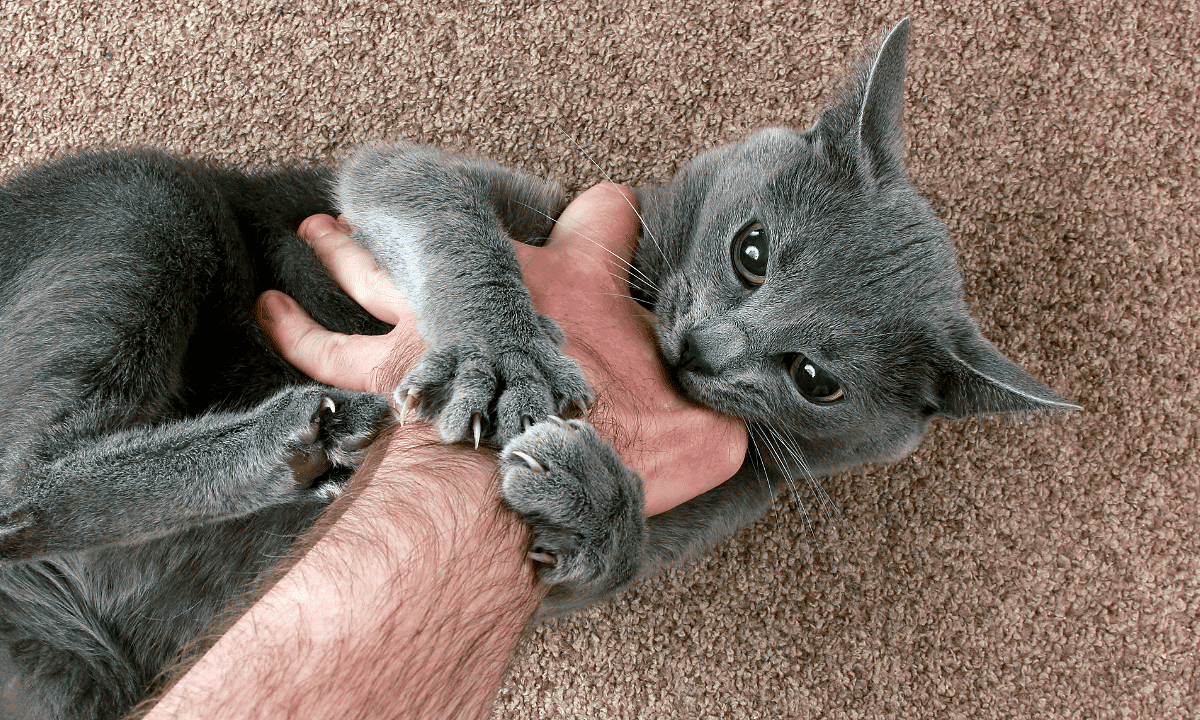

I will know, many thanks for the information.